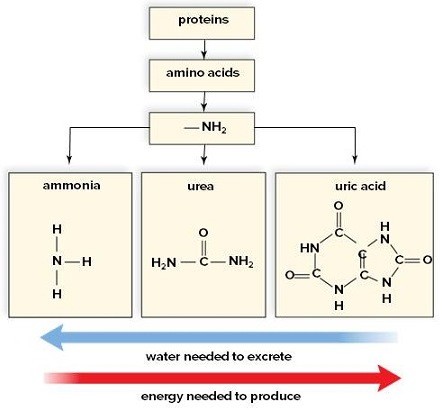Three types of nitrogenous wastes formed from the breakdown of protein are pictured in the diagram.  a- Explain the relationship of the water needed to excrete the wastes and the energy required to produce the wastes.b- How is the energy needed to produce the waste and the water needed to eliminate the waste related to the nature of each waste product?c- Tell what types of organism produce each type of waste.
a- Explain the relationship of the water needed to excrete the wastes and the energy required to produce the wastes.b- How is the energy needed to produce the waste and the water needed to eliminate the waste related to the nature of each waste product?c- Tell what types of organism produce each type of waste.
What will be an ideal response?
There is an inverse relationship between the water needed to excrete the waste and the energy needed to produce the waste. The amino groups produced in the breakdown of proteins immediately form ammonia. Little to no energy is used to produce ammonia, as indicated in the diagram. However, ammonia is very toxic and, if used as an excretory product, requires that much water is available to wash it out of and away from the body. Therefore, fish and other aquatic animals excrete ammonia.
Uric acid is on the other end of the spectrum. Much energy is required to produce uric acid, but little water is needed to excrete uric acid. It is not very toxic, nor is it very soluble in water. These are advantages in an environment where water must be conserved. Uric acid is excreted by insects, reptiles, and birds.
Urea is in between ammonia and uric acid in water required and energy expended during its production. Since urea is not very toxic, it can be excreted in moderately concentrated solution. Adult amphibians, sharks, and mammals usually excrete urea as their main nitrogenous waste.
You might also like to view...
During their experiments with chlorella, Calvin and Benson found no free glucose. Why do you think this is?
A. Glucose takes too long to synthesize. B. Glucose is an isomer of fructose. C. Glucose is stored as starch. D. Glucose would cause H2O to leave the chlorella cells. E. Green algae do not respire when illuminated.
A(n) ________ layer is a layer of protein or glycoprotein that exhibits a pattern resembling floor tiles.
Fill in the blank(s) with the appropriate word(s).
Duplicated chromosomes linked together at their centromeres at the beginning of meiosis are appropriately called what
kind of chromatids? a. mother b. parallel c. sister d. homogenous e. haploid
All EXCEPT which of the following must be
available for the light-independent reactions to occur? a. carbon dioxide b. oxygen c. ribulose bisphosphate d. ATP and NADPH e. enzymes